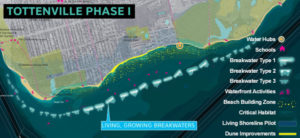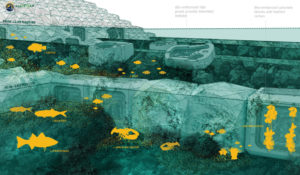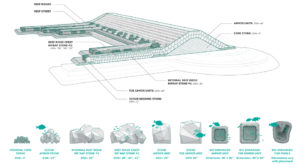Resilience: Readying for Another Superstorm

Picking up where I last left off on resiliency, Development Projects Featuring “Resilience” to Climate Change (Pt 2), I noted a major project is well underway to help lessen the effects of future extreme climate events on the people and property on Staten Island. You’ll recall Superstorm Sandy absolutely clobbered Staten Island in 2012, claiming 233 lives and $Bs in property destruction?
AIA Baltimore’s guest lecturer back in late March was Gena Wirth, Design Principal at SCAPE, a landscape and urban design studio in NYC. Her topic: “Climate Change Migration.”
One of the projects she talked about is the subject of today’s post; their winning design, in collaboration with engineering firm Parsons Brinckerhoff and others, for the $60M Living Breakwaters competition for Staten Island.
Offered at the presentation was a handout which reads that newly constructed in-water infrastructure at Staten Island, adaptive to future climate change, will be linked with on-shore education to increase public awareness of ecosystems, their restorations and maintenance requirements.
Back in June 2013, HUD launched a competition called “Rebuild by Design” in response to Superstorm Sandy. The principal goal was to promote a design-led approach to proactive planning for long-term resilience and climate change adaptation.”
According to the NYS Governor’s Office of Storm Recovery (GOSR), one of the selected projects was: “The Staten Island Living Breakwaters Project which proposed a layered resiliency approach to promote risk reduction through erosion prevention, wave energy attenuation, and enhancement of ecosystems and social resiliency.”
That would be Gena’s firm, as lead.


Here are excerpts from the GOSR’s report–
Project Purpose: Why Living Breakwaters?
-
Risk Reduction: Address both event-based and long-term shoreline erosion in order to preserve or increase beach width, and attenuate storm waves to improve safety and prevent damage to buildings and infrastructure.
-
Ecological Enhancement: Increase the diversity of aquatic habitats in the Lower New York Harbor/Raritan Bay (e.g., oyster reefs and fish and shellfish habitat), particularly rocky/hard structured habitat that can function much like the oyster reefs that were historically found in this area.
-
Social Resiliency: Provide programming…for coastal resiliency and ecosystem stewardship; foster and encourage community stewardship and citizen science. And, increase physical and visual access to the water’s edge and near-shore waters for recreation, education, research, and stewardship activities.


The project area is Raritan Bay (Lower New York Harbor) along the shoreline of Tottenville and Conference House Park.., “a shallow estuary that has historically supported commercial fisheries and shell fisheries.”
Tottenville, located at the southernmost point of Staten Island, was among the hardest hit by wave action in the region. Known as “The Town the Oyster Built,” the locale was once protected by a wide shelf and oyster reefs–Gena called them “reef streets”–and was harvested by local oystermen. Now, much of Staten Island’s shoreline is absent these natural systems and remains exposed to coastal erosion and extreme wave action.
The SCAPE project consists of:
- Living Breakwaters: An approx. 4,000LFT system of near-shore “breakwaters,” or partially submerged structures, located 730 to 1,200 ft. from shore designed not only to reduce risk, but also to provide habitat enhancements through the specialized design of the breakwater structures and use of select materials.
- Shoreline restoration: Sand replenishment to restore the 1978 shoreline alignment from Manhattan St. to Loretto St. (where the distance between the shore and buildings is most narrow and subject to erosion).
- Active oyster restoration by the Billion Oyster Project: Oyster installations on the breakwaters themselves. Also, oyster cultivation activities (hatching, remote setting, etc.), shell collection and curing and oyster nurseries to be installed.
- A Water Hub: Provide a public facility for educational programs, water and shoreline stewardship activities, science and monitoring efforts, and recreational program and equipment and exhibitions related to the project.
- Programming: Include educational, stewardship, and workforce training activities related to the other project elements.

Some of you are going to want to spend the nearly 12 mins. viewing this video case study of the project’s design considerations, conception and development. Great stuff!